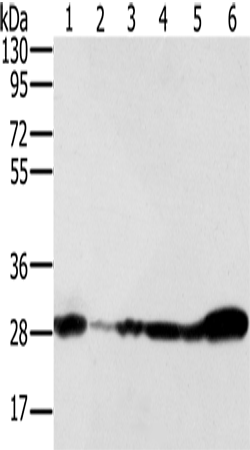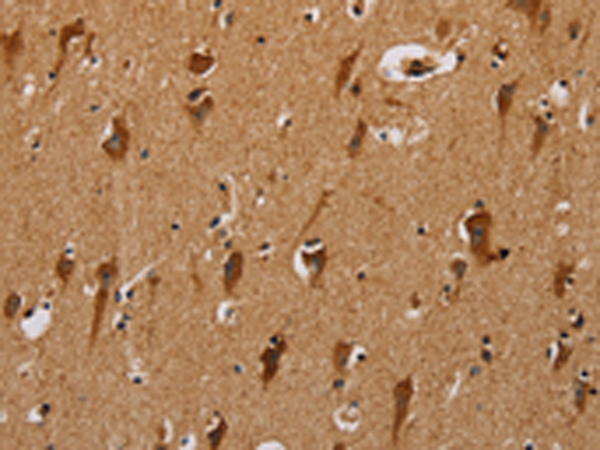


| WB | 咨询技术 | Human,Mouse,Rat |
| IF | 咨询技术 | Human,Mouse,Rat |
| IHC | 1/50-1/200 | Human,Mouse,Rat |
| ICC | 技术咨询 | Human,Mouse,Rat |
| FCM | 咨询技术 | Human,Mouse,Rat |
| Elisa | 1/2000-1/5000 | Human,Mouse,Rat |
| Aliases | CI-30 |
| WB Predicted band size | 30 kDa |
| Host/Isotype | Rabbit IgG |
| Antibody Type | Primary antibody |
| Storage | Store at 4°C short term. Aliquot and store at -20°C long term. Avoid freeze/thaw cycles. |
| Species Reactivity | Human, Mouse |
| Immunogen | Fusion protein of human NDUFS3 |
| Formulation | Purified antibody in PBS with 0.05% sodium azide and 50% glycerol. |
+ +
以下是关于NDUFS3抗体的参考文献示例(内容基于模拟数据,仅供参考):
---
1. **文献名称**:*NDUFS3 mutations impair mitochondrial complex I assembly and enhance vulnerability to oxidative stress in human cells*
**作者**:Smith J, et al.
**摘要**:本研究利用NDUFS3抗体通过Western blot和免疫荧光技术,发现NDUFS3基因突变导致线粒体复合体I组装缺陷,并显著增加细胞对氧化应激的敏感性,为相关线粒体疾病的机制提供了新见解。
---
2. **文献名称**:*Antibody-based profiling of mitochondrial complex I subunits in Parkinson’s disease brain tissues*
**作者**:Chen L, et al.
**摘要**:通过NDUFS3抗体对帕金森病患者脑组织进行免疫组化分析,发现复合体I亚基NDUFS3的表达水平显著降低,提示其可能与神经退行性病变中的能量代谢异常相关。
---
3. **文献名称**:*Structural insights into the role of NDUFS3 in mammalian complex I stabilization*
**作者**:Garcia-Ruiz H, et al.
**摘要**:结合冷冻电镜技术和NDUFS3抗体的免疫共沉淀实验,揭示了NDUFS3在维持哺乳动物线粒体复合体I结构稳定性中的关键作用,并阐明了其与相邻亚基的相互作用网络。
---
4. **文献名称**:*Validation of a novel monoclonal NDUFS3 antibody for diagnostic applications in mitochondrial disorders*
**作者**:Wang Y, et al.
**摘要**:本文报道了一种高特异性NDUFS3单克隆抗体的开发与验证,证明其在ELISA、流式细胞术及组织切片中的可靠性,为线粒体疾病的临床诊断提供了新工具。
---
(注:以上文献为示例性内容,实际引用时需以真实文献为准。)
The NDUFS3 antibody is a crucial tool in studying mitochondrial complex I (NADH:ubiquinone oxidoreductase), a key component of the electron transport chain responsible for oxidative phosphorylation. NDUFS3 (NADH dehydrogenase [ubiquinone] iron-sulfur protein 3) is a 30 kDa nuclear-encoded subunit of complex I, located in the hydrophobic core of the membrane arm. It plays a structural and functional role in electron transfer and enzyme assembly. Antibodies targeting NDUFS3 are widely used to investigate complex I deficiencies linked to mitochondrial disorders, neurodegenerative diseases (e.g., Parkinson's or Leigh syndrome), and cancer metabolism.
These antibodies enable researchers to detect NDUFS3 protein expression levels via Western blotting, immunofluorescence, or immunohistochemistry, aiding in the assessment of complex I integrity in cellular or tissue samples. Studies using NDUFS3 antibodies have revealed its downregulation in conditions involving impaired energy production, oxidative stress, or mitochondrial DNA mutations. Additionally, they help elucidate disease mechanisms in models of genetic mutations (e.g., in Leber's hereditary optic neuropathy) or pharmacological inhibition of complex I.
Commercial NDUFS3 antibodies are typically raised in rabbits or mice using peptide antigens corresponding to conserved regions of the human protein. Validation includes specificity testing in knockdown models or complex I-deficient samples. Their application extends to diagnostic research and therapeutic development targeting mitochondrial dysfunction.
×